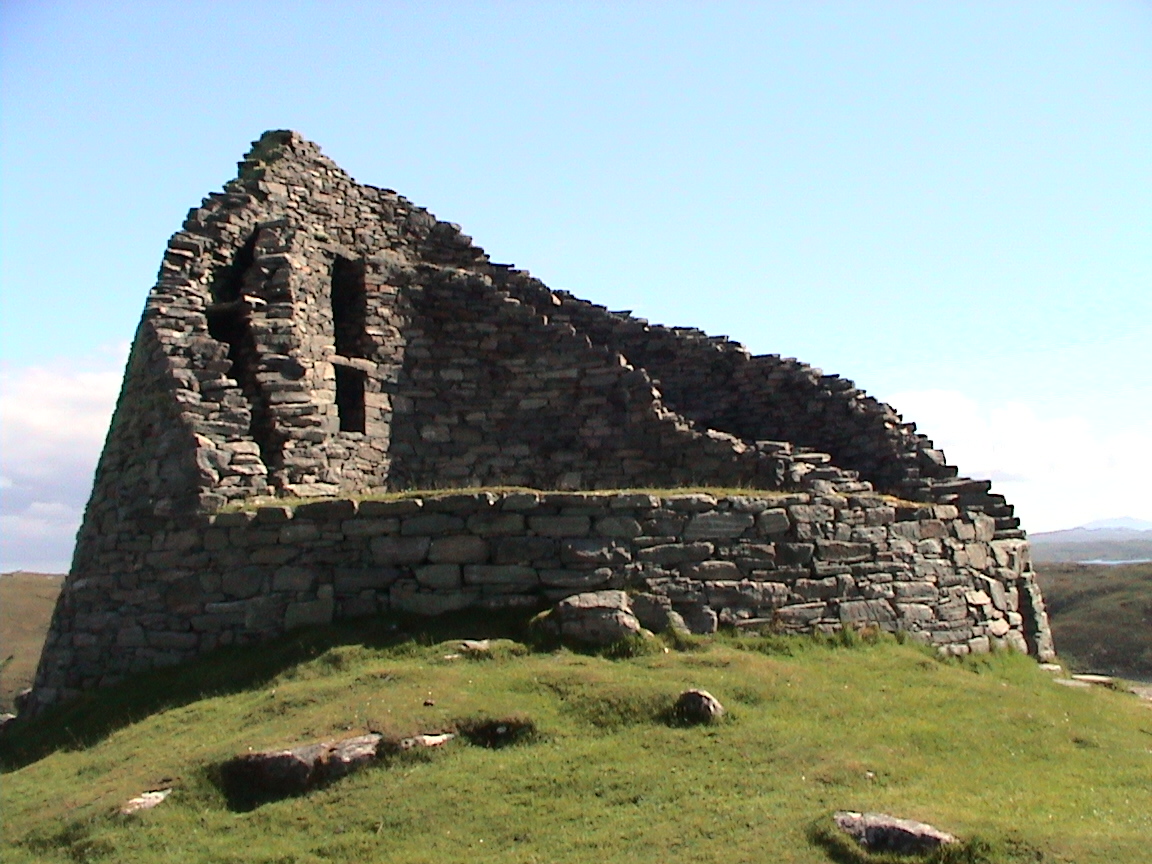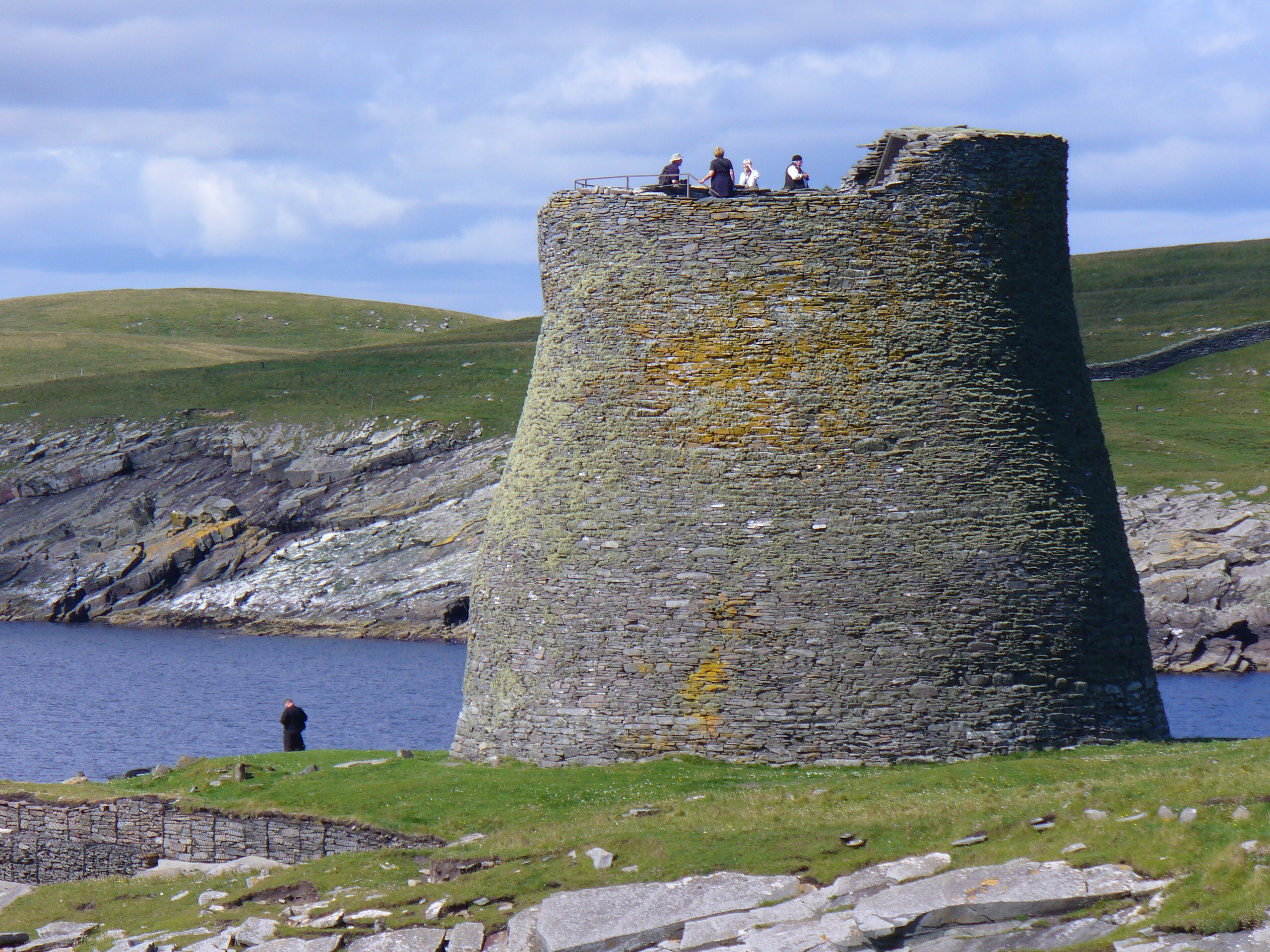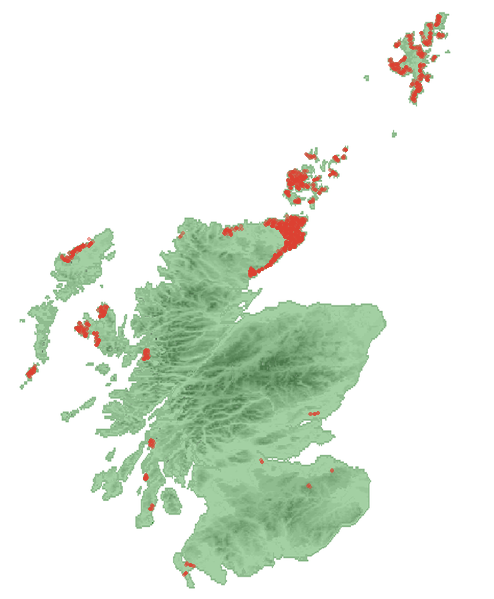|
Dun Grugaig
Dun Grugaig (or Caisteal Chonil) is a D-shaped dun, or "semi- broch", located about 7 kilometres southeast of the village of Glenelg, Highland, in Scotland (). Location Dun Grugaig stands on the north bank of the Abhainn a’Ghlaine Bhig, in the upper reaches of Gleann Beag. It is in the same valley as the two Glenelg brochs of Dun Telve and Dun Troddan. Unlike those two brochs which are in the valley close to flat ground, Dun Grugaig is situated on rugged rising ground. It should not be confused with the broch known as Caisteal Grugaig a few miles to the north. Description Dun Grugaig is a D-shaped fortification (dun) of a type commonly regarded as a prototype broch or "semi-broch". It was built with the straight side of the fort facing the edge of the precipice on the east. It measures about 17 by 12 metres. It has the hollow-wall construction which is characteristic of later brochs. The partly lintelled southeast doorway appears to be the main entrance into the building; t ... [...More Info...] [...Related Items...] OR: [Wikipedia] [Google] [Baidu] |
Scottish Highlands
The Highlands ( sco, the Hielands; gd, a’ Ghàidhealtachd , 'the place of the Gaels') is a historical region of Scotland. Culturally, the Highlands and the Lowlands diverged from the Late Middle Ages into the modern period, when Lowland Scots replaced Scottish Gaelic throughout most of the Lowlands. The term is also used for the area north and west of the Highland Boundary Fault, although the exact boundaries are not clearly defined, particularly to the east. The Great Glen divides the Grampian Mountains to the southeast from the Northwest Highlands. The Scottish Gaelic name of ' literally means "the place of the Gaels" and traditionally, from a Gaelic-speaking point of view, includes both the Western Isles and the Highlands. The area is very sparsely populated, with many mountain ranges dominating the region, and includes the highest mountain in the British Isles, Ben Nevis. During the 18th and early 19th centuries the population of the Highlands rose to around 300,000, but ... [...More Info...] [...Related Items...] OR: [Wikipedia] [Google] [Baidu] |
Broch
A broch is an Iron Age drystone hollow-walled structure found in Scotland. Brochs belong to the classification "complex Atlantic roundhouse" devised by Scottish archaeologists in the 1980s. Their origin is a matter of some controversy. Origin and definition The word ''broch'' is derived from Lowland Scots 'brough', meaning (among other things) fort. In the mid-19th century Scottish antiquaries called brochs 'burgs', after Old Norse ', with the same meaning. Place names in Scandinavian Scotland such as Burgawater and Burgan show that Old Norse ' is the older word used for these structures in the north. Brochs are often referred to as ''duns'' in the west. Antiquarians began to use the spelling ''broch'' in the 1870s. A precise definition for the word has proved elusive. Brochs are the most spectacular of a complex class of roundhouse buildings found throughout Atlantic Scotland. The Shetland Amenity Trust lists about 120 sites in Shetland as candidate brochs, while the Royal C ... [...More Info...] [...Related Items...] OR: [Wikipedia] [Google] [Baidu] |
British Iron Age
The British Iron Age is a conventional name used in the archaeology of Great Britain, referring to the prehistoric and protohistoric phases of the Iron Age culture of the main island and the smaller islands, typically excluding prehistoric Ireland, which had an independent Iron Age culture of its own. The parallel phase of Irish archaeology is termed the Irish Iron Age. The Iron Age is not an archaeological horizon of common artefacts but is rather a locally-diverse cultural phase. The British Iron Age followed the British Bronze Age and lasted in theory from the first significant use of iron for tools and weapons in Britain to the Romanisation of the southern half of the island. The Romanised culture is termed Roman Britain and is considered to supplant the British Iron Age. The tribes living in Britain during this time are often popularly considered to be part of a broadly-Celtic culture, but in recent years, that has been disputed. At a minimum, "Celtic" is a linguistic ter ... [...More Info...] [...Related Items...] OR: [Wikipedia] [Google] [Baidu] |
Broch
A broch is an Iron Age drystone hollow-walled structure found in Scotland. Brochs belong to the classification "complex Atlantic roundhouse" devised by Scottish archaeologists in the 1980s. Their origin is a matter of some controversy. Origin and definition The word ''broch'' is derived from Lowland Scots 'brough', meaning (among other things) fort. In the mid-19th century Scottish antiquaries called brochs 'burgs', after Old Norse ', with the same meaning. Place names in Scandinavian Scotland such as Burgawater and Burgan show that Old Norse ' is the older word used for these structures in the north. Brochs are often referred to as ''duns'' in the west. Antiquarians began to use the spelling ''broch'' in the 1870s. A precise definition for the word has proved elusive. Brochs are the most spectacular of a complex class of roundhouse buildings found throughout Atlantic Scotland. The Shetland Amenity Trust lists about 120 sites in Shetland as candidate brochs, while the Royal C ... [...More Info...] [...Related Items...] OR: [Wikipedia] [Google] [Baidu] |
Glenelg, Highland
Glenelg ( gd, Glinn Eilg, also ''Gleann Eilg'' is a scattered community area and civil parish in the Lochalsh area of Highland in western Scotland. Despite the local government reorganisation the area is considered by many still to be in Inverness-shire, the boundary with Ross-shire (where the post town of Kyle of Lochalsh is situated) being at the top of Mam Ratagan ("Ratagan Gap" or "pass") the single-track road entry into Glenelg. The main village is called Kirkton of Glenelg and commonly referred to as "Glenelg". There is a smaller hamlet less than to the south by the jetty and skirting Glenelg Bay known as Quarry. There are several other clusters of houses scattered over Glenelg including up Glen Beag and Glen More and on the road leading to the ferry at Kyle Rhea. The parish covers a large area including Knoydart, North Morar and the ferry port of Mallaig. At the 2001 census it had a population of 1,507. The smaller "settlement zone" around Kirkton had a population of 28 ... [...More Info...] [...Related Items...] OR: [Wikipedia] [Google] [Baidu] |
Dun Telve
Dun Telve ( gd, Dùn Teilbh) is an iron-age broch located about southeast of the village of Glenelg, Inverness-shire in the Highland Region of Scotland. It is one of the best preserved brochs in Scotland. Location Dun Telve () stands on the north bank of the Abhainn a’ Ghlinne Bhig, in the lower reaches of Gleann Beag. It lies next to the minor road which leads south from Glenelg. The neighbouring broch of Dun Troddan lies to the east, and the "semi-broch" known as Dun Grugaig is around further east. History It is thought that the broch was robbed for stone in 1722 (probably for the building of Bernera Barracks in Glenelg). Dun Telve was popular with tourists by the late 18th century, and was first sketched in the late 18th century. It was surveyed in detail in 1871–1873 by Henry Dryden. The building was brought into state care between 1882 and 1901 and the boundary markers that define the area of guardianship are still visible. Around 1914 a programme of works was under ... [...More Info...] [...Related Items...] OR: [Wikipedia] [Google] [Baidu] |
Dun Troddan
Dun Troddan ( gd, Dùn Trodan) is an iron-age broch located about southeast of the village of Glenelg, Highland, in Scotland. It is one of the best-preserved brochs in Scotland. Location Dun Troddan () stands on a level rock platform north of the Abhainn a’ Ghlinne Bhig, in the lower reaches of Gleann Beag. It lies just north of the minor road leading south from Glenelg. It can be accessed via a steep path. The neighbouring broch of Dun Telve lies to the west, whilst the "semi-broch" known as Dun Grugaig is around to the southeast. History Dun Troddan was first sketched in about 1720 when it was still an intact tower. It is thought that it was over high in 1720, and it was described as being "by far the most entire of any in that Country". It was robbed for stone in 1722 during the construction of Bernera Barracks in Glenelg. The broch was visited by Thomas Pennant in 1772, and it was still a substantial structure, although it had lost the upper gallery by this time. I ... [...More Info...] [...Related Items...] OR: [Wikipedia] [Google] [Baidu] |
Caisteal Grugaig
Caisteal Grugaig (or Dun Totaig) is an Iron Age broch near the eastern end of Loch Alsh in the Scottish Highlands (). Location The broch is located in the district of Lochalsh, and is about 9 kilometres northwest of Shiel Bridge. It stands on a small rocky knoll on a grassy slope. The "Glenelg Brochs" of Dun Telve and Dun Troddan are a few miles to the south. Caisteal Grugaig should not be confused with the "semi-broch" known as Dun Grugaig which is also near Glenelg. Description The broch has an external diameter of around 16.5 metres and an internal diameter of around 9.6 metres. The broch was built on uneven ground, so the natural floor of the broch has a slope. The entrance passage is on the northeast side and has a massive triangular lintel over the doorway. There is an elongated guard cell on the left side of the entrance passage. The interior of the broch has two intramural rooms at ground level, one of which is a small, oval cell. The other is a long mural cell, or ... [...More Info...] [...Related Items...] OR: [Wikipedia] [Google] [Baidu] |
Alexander Gordon (antiquary)
Alexander Gordon (1755) was a Scottish antiquary and singer. His survey of Roman sites, the ''Itinerarium Septentrionale'', was considered an essential reference by all Roman antiquaries of his time. Early life and education Gordon was born at Aberdeen, Scotland, not later than 1692. After earning an M.A. at the University of Aberdeen, where he distinguished himself by his classical attainments, he resided for a time in the city, eking out a living as a teacher of languages and music. He also painted portraits in oil. He afterwards visited the continent, at first probably as a tutor, and returned home an excellent French and Italian scholar, and with a good knowledge of art and antiquities. He told William Stukeley that when at Capua with Sir George Byng (afterwards Viscount Torrington) "they sav'd the fine amphitheatre there, the 3rd in the world, which the Germans were going to pull down to repair the fortifications, by speaking to the governor & viceroy at Naples." He stu ... [...More Info...] [...Related Items...] OR: [Wikipedia] [Google] [Baidu] |
Archaeological Sites In Highland (council Area)
Archaeology or archeology is the scientific study of human activity through the recovery and analysis of material culture. The archaeological record consists of Artifact (archaeology), artifacts, architecture, biofact (archaeology), biofacts or ecofacts, archaeological site, sites, and cultural landscapes. Archaeology can be considered both a social science and a branch of the humanities. It is usually considered an independent academic discipline, but may also be classified as part of anthropology (in North America – the four-field approach), history or geography. Archaeologists study human prehistory and history, from the development of the first stone tools at Lomekwi in East Africa 3.3 million years ago up until recent decades. Archaeology is distinct from palaeontology, which is the study of fossil remains. Archaeology is particularly important for learning about prehistoric societies, for which, by definition, there are no written records. Prehistory includes ove ... [...More Info...] [...Related Items...] OR: [Wikipedia] [Google] [Baidu] |
Brochs
A broch is an Iron Age drystone hollow-walled structure found in Scotland. Brochs belong to the classification "complex Atlantic roundhouse" devised by Scottish archaeologists in the 1980s. Their origin is a matter of some controversy. Origin and definition The word ''broch'' is derived from Lowland Scots 'brough', meaning (among other things) fort. In the mid-19th century Scottish antiquaries called brochs 'burgs', after Old Norse ', with the same meaning. Place names in Scandinavian Scotland such as Burgawater and Burgan show that Old Norse ' is the older word used for these structures in the north. Brochs are often referred to as ''duns'' in the west. Antiquarians began to use the spelling ''broch'' in the 1870s. A precise definition for the word has proved elusive. Brochs are the most spectacular of a complex class of roundhouse buildings found throughout Atlantic Scotland. The Shetland Amenity Trust lists about 120 sites in Shetland as candidate brochs, while the Royal Co ... [...More Info...] [...Related Items...] OR: [Wikipedia] [Google] [Baidu] |







.jpg)
